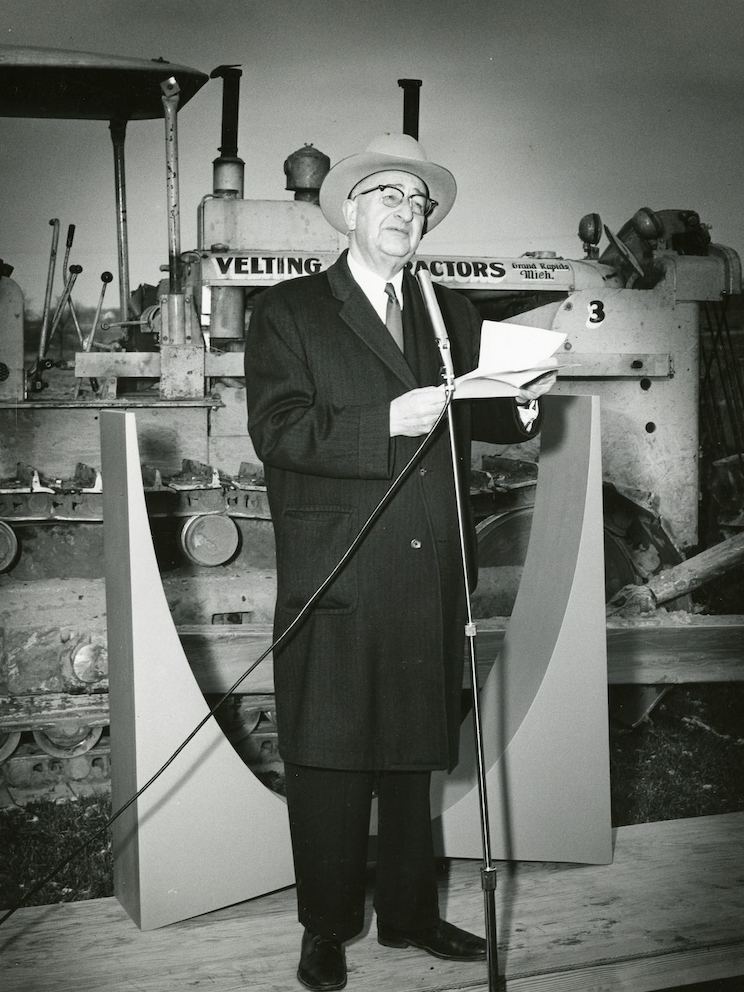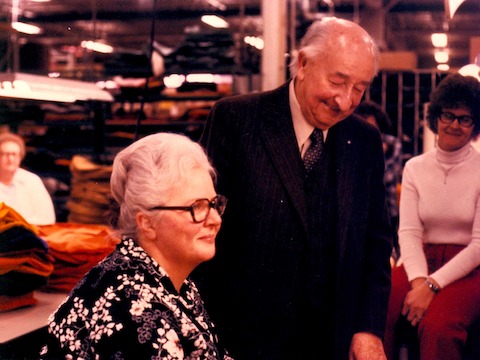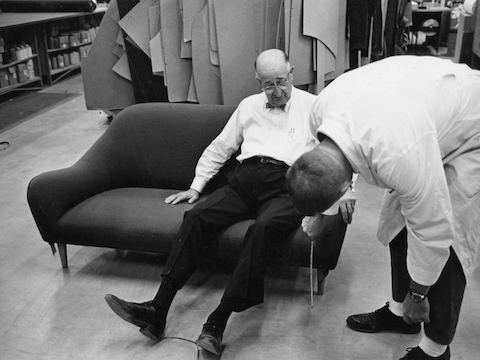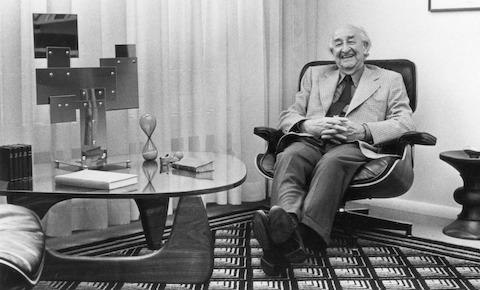The Extraordinary Man
With this 1978 essay, inventor and researcher Robert Propst pays homage to Herman Miller’s founder D.J. De Pree. If Action Office served as a systematic proposal for fostering success through optimal environmental conditions, here Propst examines the conditions—both cognitive and physical—generated by De Pree to foster his personal and professional prosperity.
Written by: Robert Propst
D.J. De Pree is a most singular person. Today at 87, his clear eyes reveal a man of style and simplicity with a still rare and unjaded measure of life and its meaning.
By D.J.’s disarming, self-effacing account, he and the business organization he created have been blessed by a succession of providential events. But others would perhaps see this in a different light. He is the providential effect with his graceful insights into qualities of living value, of the responsibilities and mission of business, of the potential in people. Perhaps most providential has been his unique creativity in providing a bold stage for others’ acts of creativity.
For D.J., this all came about through a series of formative personal discoveries. Like many accomplished achievers, D.J. De Pree can point to decisive influences in his life. Through the years, from high school on, there have always been the people: many were indeed leading writers, thinkers, pioneers. A great many more, however, are simply people perceived by D.J. for their special “light under a bushel” qualities. Such diverse people as Amos R. Wells, who in 1910 caught D.J.’s eye with an article on planning priorities day-by-day. This had immediate effect and D.J. discovered he could get his work done by noon. Now he had the afternoon free to pursue other interests. He began to pursue efficiency ideas and discovered the Gilbreths of “Cheaper by the Dozen” fame, who were industrial engineering pioneers. Eventually he met the widowed Mrs. Gilbreth, who was still active professionally.
Unlike most of us who pursue attractive avenues of least resistance, D.J. has always engaged in improving himself in areas where he perceived personal weaknesses. He did not like bookkeeping, but as a young manager he applied himself and made his mark with his tough-minded first employer, J.A. Elenbaas, a man with a very high regard for diligence and economy. Elenbaas owned the Michigan Star Furniture Company, and D.J. became the general manager.
Among the small business furniture manufacturing community of Zeeland, Michigan, thrift and profit were hallowed themes. The no-nonsense, Dutch descendant businessmen of the community included Herman Miller, who was to become D.J.’s father-in-law. And in 1923, D.J. and his father-in-law and a small group of investors purchased the Star Furniture Company. D.J., at 32, was the general manager.

The company name was changed to Herman Miller Furniture Company, which in D.J.’s view was a way to instill a quality image based on his father-in-law’s fine business reputation in the Grand Rapids area. Eventually, this decision would take on a slight irony as D.J.’s capacity for personal growth and enlargement led the company in directions that his father-in-law felt were unrealistic and injudicious.
From almost any perspective one would judge that D.J. was already an exceptional young man on the rise as a management star. However, he modestly says only that his father-in-law wanted to see his children (and son-in-law) get ahead in the world.
But Herman Miller was to remain D.J.’s sternest critic, and at a low point in D.J.’s career in 1924, judged his son-in-law as “not a money maker.” While the father-in-law could always point to his own company, The Colonial Clock Company, as a paragon in quality and profitability, D.J. would presently show the world an enterprise of unique contribution and value.
D.J. describes himself in the late 1920s as a somewhat conventionally motivated businessman, although his dedication to Christianity was already a profound force in his life. Still he feels he had yet to experience what he regards as an essential turning point in his attitude towards people. As he puts it, the prevalent management view at this time toward underlings or factory employees was expressed as “those birds out in the factory.”
A curious experience triggered D.J.’s “discovery of the man behind the man”. A long time employee, Herman Rummelt, died suddenly. At the funeral, visiting with the widow, D.J. found out for the first time that this employee, who had worked for years in maintenance at the plant, was in his own way a person of unusual interests and outstanding personal qualities.
It shocked D.J. that he had known so little of this employee’s true dimension during his life. Coming back from the funeral, D.J. made a decision—“You have to look at people as either ordinary or extraordinary. You have to choose.”
His conclusion was that people are extraordinary, that everyone possesses extraordinary qualities that provide the answer to doing things you can’t do yourself. This became his business philosophy. He began to regard every man as his peer.


Thus, a personal decision was put in place that would, over the next 45 years, bring about the unique flowering of talents and contributions that would set Herman Miller quite aside from the narrow, manneristic patterns of the rest of the furniture industry.
Characteristic of his special vision of organizational life, he recognized the things that would destroy good decision making—idolatry and covetousness, lasciviousness, giving in to the opinions of everyone, pride, envy and bitterness—concerns not likely to be lectured on in schools of business or debated in the boardrooms of industry.
Another momentous circumstance shaped Herman Miller as an organization. In 1930, D.J. realized that the company, in its undercapitalized condition, and with declining volume, would be out of business in a year. The depression delivered a crisis which would severely test D.J.’s capacity to create a new world for the Herman Miller Company. While most organizations were turning inward in gritty struggles to survive, D.J. looked through this negative looking glass to a very different world of new values, new people, and new ideas.
In the heat of this struggle for survival he was able to make a crucial assessment. Was it possible that his furniture company was providing living environments of dubious value? Were consumers offered only interiors stuffed with over-scaled, over-elaborate, jaded furnishings? With a personal candor that is a hallmark of his character he asked himself, what could Herman Miller do uniquely? He resorted to prayer, asking God for guidance.
In 1935, the decision was made to drop period furniture even though it was the furniture success of that era. This was partly the result of D.J.’s visit to the World’s Fair held in Chicago in 1932. As part of the fair there was an exhibit of modern homes, one of which was “the House of Tomorrow” furnished by Herman Miller with Gilbert Rohde’s designs. D.J. sat in the rooms listening to the comments of people, all kinds of people, working class people. He was impressed with their common sense reaction to what they saw, more value per dollar than in the period furniture of the past.
He emerged from this experience with a conviction, not just a preference. “Herman Miller would go sled-length into modern design.”
“Was it possible that his furniture company was providing living environments of dubious value? Were consumers offered only interiors stuffed with over-scaled, over-elaborate, jaded furnishings?”

The years to follow were ones where Gilbert Rohde, George Nelson, Charles and Ray Eames, and Alexander Girard were to find themselves in an unexpected association with a very provocative and interesting small furniture company in Zeeland, Michigan. Their thoughtful, solid new perceptions of design were brought forward to public view with such graceful restraint by D.J. that it became hard to believe that this was the action and intent of a business organization.
The author’s own involvement with D.J., which began in 1957 with a Denver visit by D.J. to the Propst Company’s completely unpretentious alley workshop, is an example of his capacity to see extraordinary possibilities in a situation that would have looked unpromising to most furniture industry executives.
In another world completely aside from design, it was probably inevitable that D.J.’s curiosity would take him to new ideas in organizational management. In 1949, he became acquainted with industrial psychologist Carl Frost, who introduced early concepts of participatory management. Now the extraordinary potential that D.J. envisioned in every person could be realized. In effect, everyone could assume management responsibility, and from this grew Herman Miller’s pioneering involvement in the Scanlon Plan implementation—a model of productivity of continuing interest to the business community.
D.J.’s demeanor is unfailingly kind, courteous, and engaging. But he is not one to coddle an inane discussion. Rather quickly you find yourself drawn into matters that may test your opinion, your judgments, the size of your mental world. He is a listener who listens.
Relationships with D.J. settle rather quickly into positions of one-to-one candor. It’s not what your business card may say, or a facade you may use for the rest of the world, that survives. Thus, knowing D.J. is not an altogether easy self-indulgence. But for those who can stand a certain measure of self-examination, it can be an association of enduring value. As Gene Eppinger, a former long-time Herman Miller manager, puts it: “Relationships operated on a basis of truth with each other. You could always tell the truth, and like a good family, the strengths and weaknesses that everyone carries to situations were accepted.”


D.J.’s greatest strength as a businessman may well be his consummate belief in trust as the keystone ingredient in relationships; that business still functions largely because people have trust in each other’s word, commitment, and actions, Business arrangements with D.J. were put in place with simple agreement. The forever rusting chains of legal documents have not been the ties that welded together the accomplishers at Herman Miller.
For consistency in relationships, one has to consider the career length association of Hannah Mae Borst as D.J.’s secretary. Perhaps unprecedented, Hannah Mae has held this position for 56 years and continues to this day. This modest, witty lady, not surprisingly exhibits many of the same qualities as D.J. She sets high standards and has some steel of her own, as a kind of alter ego, right arm, she has been a stickler for detail and correctness. With D.J.’s volatile capacity for multi-faceted interests, she has provided a complementary counterpoint in making things work.
D.J.’s working life has been shaped by a lifelong quest for knowledge. Though he laughs at the idea, he is by Webster’s definition of a scholar, “one who has the attitudes (i.e., curiosity, perseverance, initiative, originality, integrity) considered essential for learning.”
This pursuit of personal enlargement has been guided by a self-discipline that instills a kind of perpetual liberalizing effect. While most of us read less after we leave school, or meet only the people who fall mechanically in our path, D.J. set a regime for himself that would assure growth and expansion of horizons. Moreover, this discipline is still in place.
A great believer in the tickler file idea, D.J. developed a method of setting weekly objectives. This is no mere calendar of events and appointments. A page from his weekly activity log of April 24, 1978, shows a catalog of objectives, things to do, people to meet, questions to ask—a week of zestful involvements.
“D.J.’s working life has been shaped by a lifelong quest for knowledge.”

There is one novel aspect of this particular week in the activity life of D.J. De Pree. It shows no books to read. But his life has been full of books, and his office at home shows his scholar’s affinity for books—the well-thumbed, active book place of a real reader.
D.J.’s capacity as an experimenter was tested in the early 1960s. As the early phases of Action Office began to emerge in embryonic form, the Research organization began a program of experimental installations. While a great many others were treating these early prototype efforts with ginger skepticism, D.J. became an avid student of the functional premise behind these ideas.
Thus, in 1963, an experimental office was installed in D.J.’s office at his home. This “other” office was D.J.’s real heartbeat activity center. It was here that his interests in Bible scholarship, the Gideon organization, and his activity as a lay minister were unabashedly combined with his still very active involvements at Herman Miller.

As shown in the photographs, this experiment with its standup, roll-top desk is still in place. Now the experimental Action Office units have been joined by other furnishings in a composite of D.J.’s additional needs.
Design stylists would not understand this place. But those interested in the living and working processes of an exceptional mind would find it quite engrossing. There is complexity with order, there is enrichment without self-consciousness. There is work in process in unembarrassed array. It is a place of growth, with aspirations in the wings. It is a portrait of a rich work involvement and a lesson that furnishings by themselves are merely objects in artful combination. It is the person and purposeful activity that finally create engaging and attractive workplaces.
D.J.’s quiet and open participation in the Action Office fledgling beginnings was an act of leadership. When an innovation becomes the practice and belief of leaders, others find it easier to follow.
We can never comprehend the true dimension of another person’s life any more than we understand ourselves completely. In most cases, the models of living we see around us only parallel our own sense of limitation and frustration.
Our good fortune lies in the access we have had to a gifted, extraordinary, and accessible man. He has lifted our vision and shown us what a spirit of self-abandonment can affect.
With a personal selflessness and conviction, D.J. and his sons, Hugh and Max, and now others, have made an extraordinary contribution to design and quality in the living environment. They have set the stage, provided a climate of implementation, and absorbed the mistakes without rancor, and in good humor. The company seemed to know from the beginning how to be patient, often for years, with its innovative efforts while sales grew from microscopic beginnings to eventual worldwide acceptance.




